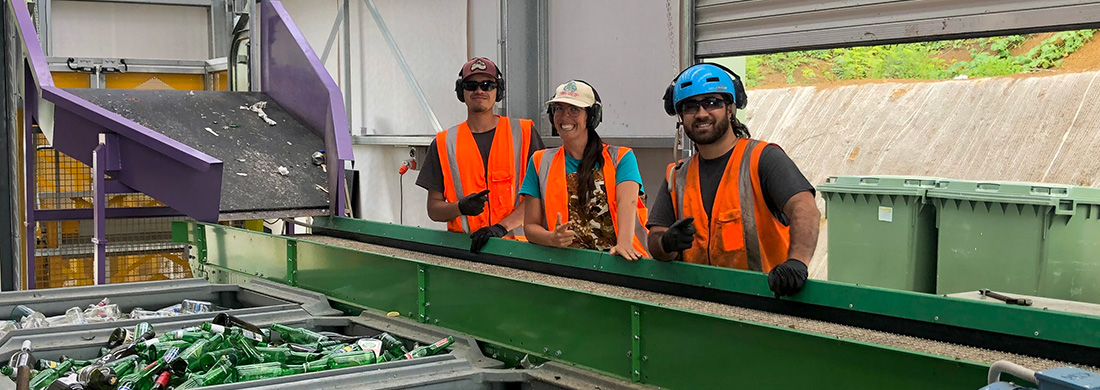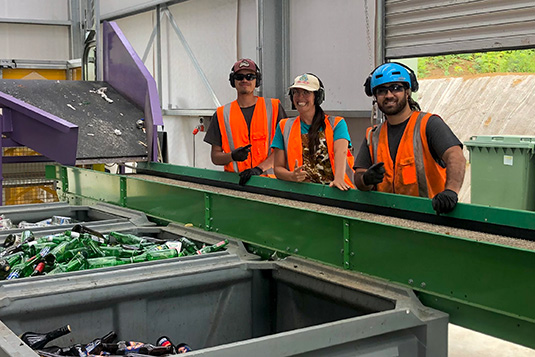
Glass heroes – Community waste warriors leading the way

Xtreme Zero Waste in Raglan is one of the country’s longest running and most successful waste warrior community groups.
Their new centre of excellence, which the Glass Packaging Forum helped fund, will not only further improve their impressive waste diversion rate, but model industry best practice for others to learn from. We chatted to their chief story teller Sarah Lancaster to find out more.
Tell us about Xtreme Zero Waste
About 22 years ago Xtreme was started by a group of community members and families who wanted to sort the water quality of the Wainui Stream because the dump was upstream. This made the water in the stream and Whāingaroa Harbour pretty toxic – you couldn’t swim or gather any kaimoana. Whaea Eva Ricard called the community into action by pointing up to the hill and saying start there.
It was also created on the kaupapa of turning the negatives of waste into lots of positives. So, rather than just focussing on one solution of reducing waste, the hope was to create many positives.
Employment is a really big one in Raglan and supporting the local economy, as well as reducing the amount of things which go into landfill.
We have the contract for all the kerbside collections, as well as business waste and we have rural depots, so we manage it all from collection to sorting and delivering premium product to our recycling partners. We’re the only resource recovery centre in New Zealand which does kerbside collections.
What have been some highlights?
One thing we are really proud of is our waste diversion rate, which is one of, if not the highest in the country at about 75% to 80%.
This is thanks to the Raglan community being so on board the kaupapa of working towards zero waste. It makes sense as our community is pretty connected to the surf, the harbour, the beach, and the maunga Karioi. So much of our lives here are connected to nature, it goes hand in hand with reducing our waste, reusing and recycling what we can. We have done a lot of education over the years, but there is definitely a sustainability backbone to the community.
We have also seen the positive benefits through local employment and particularly getting youth into employment. For example, young school leavers who come to work with us get support with their driver’s licences, wheels tracks and rollers and HT too. Their roles change here with more responsibility, more self-confidence, and growing skillsets that can set them up for great careers.
That’s an impressive diversion rate. How long did it take to achieve?
We got to 70% quite early on actually – having the reuse shop alongside the recycling service really helped. It goes to show how much of what’s thought of as landfill can actually be reused within the community.
Adding in the food waste collection has also had a significant impact as many waste audits around the country have shown food scraps make up to 40% of a household’s rubbish bag. We’re looking now at the last 20% of our diversion rate which is about behaviour change in consumer habits as well as things like construction and demolition waste.
How do you think Xtreme has had an impact in creating that low waste culture?
The culture most certainly comes from the community’s connection to our team. We are a big whanau, and many have their uncles, aunties, sons, daughters working here.
Xtreme is always there to support events in our community, with waste systems and education. Specifically, Maui Dolphin Day and the recycled raft race, an annual event hosted with the Whāingaroa Environment Centre.
We are always working with community – we’re not a big business on the hill, people understand it’s part and parcel of who the town is. We have people who worked here take their knowledge and spread it around. Like Sam Gray, who used to work here and now he owns Ethical Waste in Ohakune.
Do you still have any of the original founders working at Xtreme?
Yes, we are lucky to have had Rick Thorpe, who has just retired now but is still on the board, as well as Liz Stanway doing amazing things in the organics yard and championing the circular economy of food waste and green waste.
Smaller places like Raglan are becoming more popular for families, how’s this affected your work?
The population in Raglan has grown significantly and with new 500 home subdivisions under development we are preparing for more. It’s a great opportunity to welcome people onboard the Raglan way and encourage new habits for families.
This community growth is also another reason we have been gearing up on site to process the growing volumes of recyclables, landfill waste, and donations for re-sale. The new processing building and processing line will help our team significantly.
Tell us about the Centre of Excellence
Because we’ve been going for 22 years, we’ve learned a lot. Now, we’re kind of reinvigorating ourselves to be the centre of excellence that the newer resource recovery centres and zero waste groups can model off and offer our knowledge to them.
At the same time, we’re building the new processing centre with equipment like a new glass line, new plastics line, and new bailers. But what’s also going on around that is a lot of process work and investment in things like IT. It’s a multi-year project – taking what we have learned over the last 22 years and applying them to a new, improved way of operating which others can then follow.
We’re part of the Zero Waste Network which is a gateway for others to learn from us about all the facets, from safety systems and payroll to best practice waste diversion, and even sharing the markets which we find for the materials.
How did the recent GPF grant help with this work?
Our old system was a health and safety nightmare, and processing was being done outside – rain or shine. We are shifting all our containment, businesses and rural etc to wheelie bins. So now with the bin lifters, which the GPF helped fund, the wheelie bins are getting lifted with the bin lifter, the glass goes down the shoot and the guys are sorting off the line inside the processing building.
So, we’ve removed all the manual lifting and moving around is much safer. The glass is on a conveyor, and we think it’s improving our product quality even more. It’s definitely helped us model the industry best practice for glass recycling.


